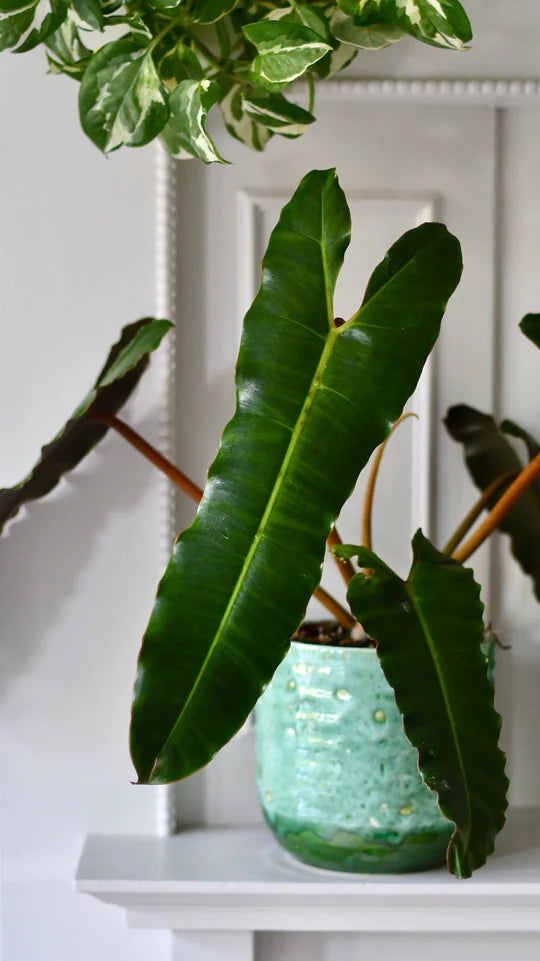Philodendron Care Guide

Philodendrons are one of the most beloved and diverse groups of houseplants, offering everything from velvety climbers to upright, architectural showstoppers. With their stunning leaves, varied forms, and easy-care nature, there's a Philodendron for every space and skill level. This guide will walk you through exactly how to help them thrive indoors.
Plant Profile
| Feature | Details |
|---|---|
| Botanical name | Philodendron spp. |
| Common names | Philodendron, Heartleaf Philodendron, Hope Plant |
| Family | Araceae |
| Plant type | Climber, trailer, or upright aroid |
| Size | 20–150cm depending on variety |
| Toxicity | Toxic if ingested by pets |
| Difficulty | Easy to moderate |
Philodendron Light requirements
Philodendrons prefer bright, indirect light but can tolerate medium or even lower light depending on the variety. Too much direct sun may scorch their leaves, while too little light can reduce leaf size and slow growth. Variegated varieties like Philodendron Birkin or Florida Ghost will need a bit more light to maintain their unique colouring.
Philodendron Watering
Water when the top few centimetres of soil feel dry. Philodendrons enjoy lightly moist soil, but overwatering is the quickest route to root rot. In winter, allow the soil to dry out a little more between waterings.
Philodendron Repotting
Repot every 1–2 years in spring if your plant has outgrown its pot or the soil is compacted. Use a chunky, well-draining mix with added perlite or bark. Many varieties, such as Philodendron tortum or Philodendron gloriosum, benefit from a wider pot rather than a deeper one to accommodate spreading roots.

Philodendron Native habitat
Philodendrons are native to tropical rainforests of Central and South America. In their natural habitat, they grow beneath the canopy—climbing trees or spreading along the forest floor in warm, humid conditions. This explains their love for dappled light, warmth, and a consistent care routine.
Styling ideas for Philodendron
Use vining types like Philodendron micans to trail from shelves or hang in baskets. Upright varieties such as Philodendron bipinnatifidum (Hope) make stunning floor plants. For a splash of colour, Pink Princess Philodendron adds deep pink variegation that's highly sought-after. Pair them with natural pots like our Tembesi range to let their foliage do the talking.
Wellness benefits of houseplants, like Philodendron
Philodendrons are calming to care for and satisfying to watch grow. Many varieties put out new leaves frequently, giving you the joy of regular progress. Their lush foliage helps create peaceful, green interiors and encourages daily connection with nature—without needing to be a plant expert.
Common Philodendron problems
-
Yellowing leaves: Often due to overwatering or poor drainage. Let the soil dry more between waterings.
-
Brown leaf tips: Caused by dry air—Philodendrons love some humidity.
-
Drooping leaves: Usually underwatering or root issues. Check soil moisture.
-
Leggy growth: Move to a brighter spot if stems are stretching.
-
Stunted growth: Could mean it's time to repot or feed.
Quick care summary
| Care Element | Recommendation |
|---|---|
| Light | Bright, indirect preferred |
| Water | Let top 2–5cm of soil dry out |
| Humidity | Medium to high |
| Feeding | Every 2–4 weeks in growing season |
| Temperature | 18–26°C |
| Pet safe? | No – toxic if ingested |
FAQs
Do Philodendrons like humidity?
Yes—especially velvety varieties like verrucosum or gloriosum. A humid environment encourages lush growth and larger leaves.
Can Philodendrons grow in low light?
They’ll survive, but growth will slow and variegation may fade. Try a shady spot for dark-leaved types like Philodendron scandens ‘Brasil’.
Should I prune my Philodendron?
Yes! Pruning helps manage size and shape, especially for vining varieties. Use clean scissors and trim just above a node.
Why are the new leaves smaller?
This usually means the plant needs more light or nutrients. Try feeding with our Organic Tropical Plant Food.

Why choose this plant?
Philodendrons are endlessly rewarding. Whether you’re styling a home office or creating a lush indoor jungle, they offer something for everyone. With so many leaf shapes, colours, and growth habits—from billietiae to pedatum—you’ll never get bored of discovering new favourites.
Featured Philodendrons from Happy Houseplants
Philodendron billietiae
A rare beauty with long, orange stems and paddle-shaped leaves. Stunning in modern interiors and surprisingly easy to grow. View Philodendron billietiae
Philodendron micans
Velvety-soft and trailing, this fast-growing variety is perfect for beginners and stylists alike. Shop Philodendron micans
Explore more
Want more houseplant advice? Read our Philodendron care guide or browse plants for shady spots. You’ll find more expert tips, styling ideas, and the full Philodendron collection on our site. And remember—why not read our houseplant blog for even more green inspiration?










Leave a comment